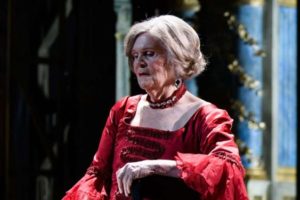
First-time novelist Matthew Gallaway’s ardent love for Tristan and Isolde gushes through every page of The Metropolis Case
. According to Gallaway, Tristan is the highest expression of human art, and the book functions effectively as the ultimate initiator in the cult of Wagner.
The novel opens with a lengthy discussion of the opera in the format of an email from an opera lover to a less-enlightened friend, and characters are forever discussing the opera, saying things like “You don’t ‘check out’ Tristan. You become it.”
This novel may be the fastest way for the average opera buff to join the high cult of Tristania (or whatever you want to call it.) Unfortunately, this novel is also a work of fiction, and Mr. Gallaway fails to create a compelling narrative. Instead, the novel is a convoluted jumble of plotlines and events that leave the reader emotionally blocked off and confused.
The Metropolis Case follows four characters in different time periods as they struggle to marry their love of art and music into their lives. Martin is a HIV-positive lawyer in 2001, facing what seems to be a mid-life crisis triggered by September 11. Maria is a tall, awkward teenager with a glorious singing voice in 1970s Philadelphia, struggling to fit in with her peers and family as she begins her trajectory towards Julliard and stardom. Anna is a dramatic soprano whose Met debut as Isolde in 1960 sparks an affair with a passionate opera lover. Finally, Lucien is a young singer in 1860s Paris, whose passion for opera and wealth of talent leads him to great heights before personal tragedy threatens to cripple his career for good.
Although these characters seem to be unrelated, there is a “twist” in this seemingly naturalistic novel which I will not reveal. However, any opera fan familiar with Janacek can probably guess the twist from the novel’s title, especially after mysterious characters with the same initials begin to show up in different time periods.
Gallaway sets so many pieces in motion that he winds up having to dip into melodrama to keep the reader guessing. Not one but two sets of parents get killed off in contrived accidents. A hackneyed interracial love affair in the seventies is for some reason included that’s more of an after-school special than anything else. Death is such a frequent contributor to the leading characters’ agonies that you find yourself waiting on who the next one to get knocked off is going to be.
What’s worse, the approaching deaths are so obviously telegraphed that it becomes a countdown to when the unlucky supporting characters finally bite it. Great historical events are thrown in: the premiere of Tristan, the Franco-Prussian war, the death of Maria Callas and of course, 9/11. None of these, even the last, which occurs in a moderately effective dreamlike passage, stands out with any great importance. They are just more events for the characters to suffer.
Martin’s sections of the book are especially heavy in suffering, although almost none of it happens in the present. His segments are frustratingly thick with flashbacks—in the first third of the novel, all he does in real time is drive to work—and even as he watches the twin towers fall it’s a cue for him to rehash the destruction of his marriage. Nothing ever really happens to Martin, and his slow journey through his own memories contrasts too greatly with the other character’s action-packed lives.
The most rewarding section was Maria’s. As she makes the transition from teenaged misfit to driven young singer, Gallaway pours his passions into her and the book is most exciting as it describes her tremendous talent. Unfortunately her pursuit of romance is less successful, both for Maria and as a plot device.
Lucien’s segments in the past are interesting but problematic due to the number of names Gallaway drops. Pauline Viardot, Hector Berlioz, Manuel Garcia (the famous pedagogue) and Wagner himself all appear, but none are ever developed as characters. They show up, chat about music for a bit, and then disappear. How an author can include Richard Wagner, one of the most fascinating and larger-than-life figures in history, in a novel and not develop him as a character is beyond me.
In fact, apart from Maria’s self-sacrificing adoptive mother, none of the supporting characters is ever really developed. The principals fall in love with ciphers, befriend two-dimensional caricatures and they have sex (a lot of it) with cardboard figures. Gallaway seems interested only in his four protagonists, and every other character in the book suffers as a result.
I suspect being a lover of Tristan might help the reader (I consider myself a Wagnerian, but I’ve yet to succumb to the pleasures of that particular opera) but really, the fault lies with the author. It feels like Gallaway, a first time author as noted above, bit off more than he could chew. In attempting to juggle four plotlines rather than one, he disservices all of them, leaving this reader unsatisfied and uninvolved.

























Comments